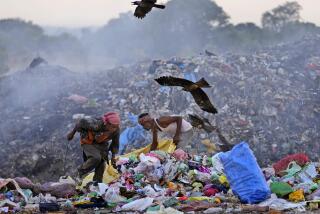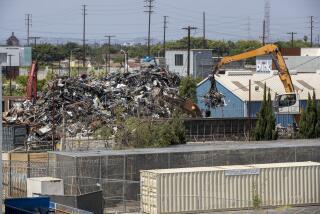WTC Scrap Is Hazardous, Activists Say
- Share via
NEW DELHI — For scrap trader Sashi Kumar, the collapse of the World Trade Center towers five months ago has become a “daily headache.”
His problems began last month when a routine shipload of steel scrap arrived in the southern port of Chennai. This time, the 33,000-ton shipment apparently included material salvaged from the site of the trade center.
Environmental and labor activists say the scrap was contaminated by other debris from the twin towers--such as cancer-causing asbestos, polychlorinated biphenyls, dioxins, mercury and lead--and they accused the United States of dumping “toxic and hazardous material” in India. They have launched an aggressive campaign calling for a halt to further movement of the scrap.
“What I have purchased is just steel scrap,” said Kumar, 36. “I believe it may contain some scrap from the WTC site, but there is no label, no sticker on the scrap that says it is WTC scrap. Now it has become a headache for me.”
The city of New York has decided to sell 175,000 tons of steel scrap from the trade center, despite emotional appeals from relatives of some of the 2,838 people killed there on Sept. 11. Some of it is going to U.S. cities, but about 60,000 tons have been sold to companies in India, China and South Korea, where it will be turned into everything from appliances and bridges to car parts and even new skyscrapers. China’s largest steel company, Shanghai Baosteel, has denied reports that it plans to make souvenirs from the metal.
“This is not normal demolition steel scrap,” said Anantha Padmanabhan, executive director of Greenpeace India. “Just look at the circumstances in which the twin towers came down. High-temperature incineration with jet fuel has taken place. This is incineration steel.”
“Each office in the WTC had computers, chip boards, tube lights, electrical lights, video and computer monitors, plastics and furniture,” he said. “There is every possibility that high levels of toxins are in the debris that would pose serious health and environmental risks to uninformed recycling workers in India.”
Indian port authorities conducted no tests on Kumar’s cargo when it arrived because it was imported as general steel scrap, which is legal in India. About 700,000 to 800,000 tons of scrap are imported into the country every year for recycling and reuse. The low import tariffs on steel scrap make it more attractive than using what is available in the country.
Part of Kumar’s New York scrap has already been sent to be used in construction, but he has agreed to allow a Greenpeace team to inspect the rest.
More steel scrap from the World Trade Center has arrived in the western Indian port of Kandla, and a third shipment is bound for the eastern city of Calcutta later this month, Greenpeace said.
“I don’t like the label ‘WTC scrap.’ In this trade, I don’t ask questions about the source of the scrap,” said Kumar, who has been in the scrap business five years.
But all the controversy about his latest consignment has made him wary. Recently, he received photographs of demolished bridges in the United States and an offer to buy the scrap from the debris.
“I said no, let’s not even talk about it. Maybe after all this I should just say I want disaster-free scrap.”
Kumar said the events of Sept. 11 weigh on him.
“If I think about the enormous tragedy, I feel very sad,” he said. “I don’t want to make a commercial deal out of disasters. But if I had said no, somebody else would have used it. It has to be used ultimately. It can’t be thrown into water.”
More to Read
Sign up for Essential California
The most important California stories and recommendations in your inbox every morning.
You may occasionally receive promotional content from the Los Angeles Times.













